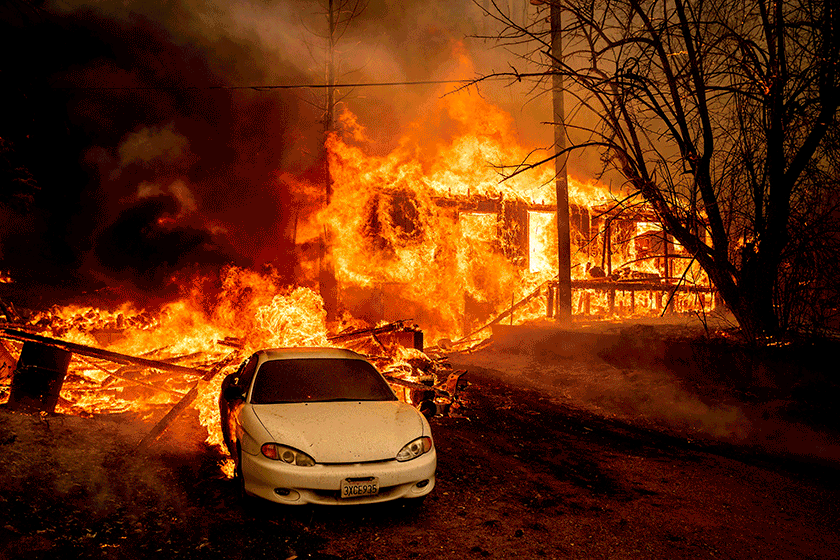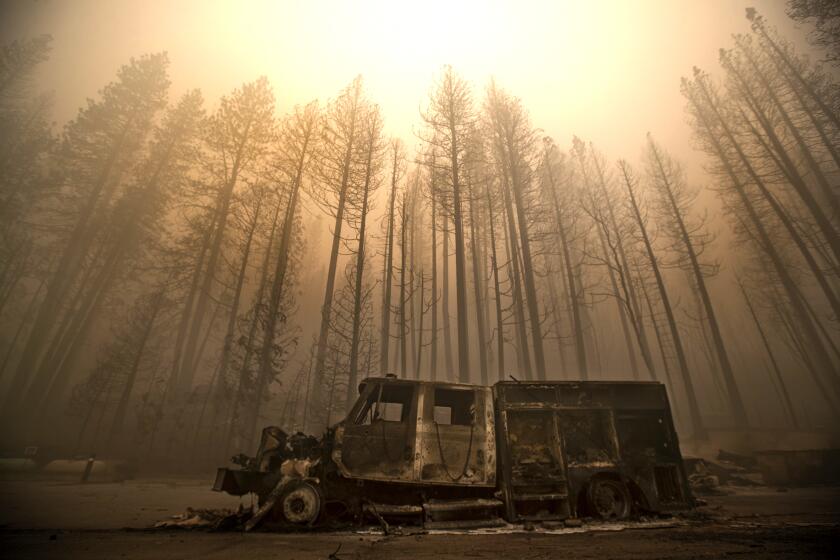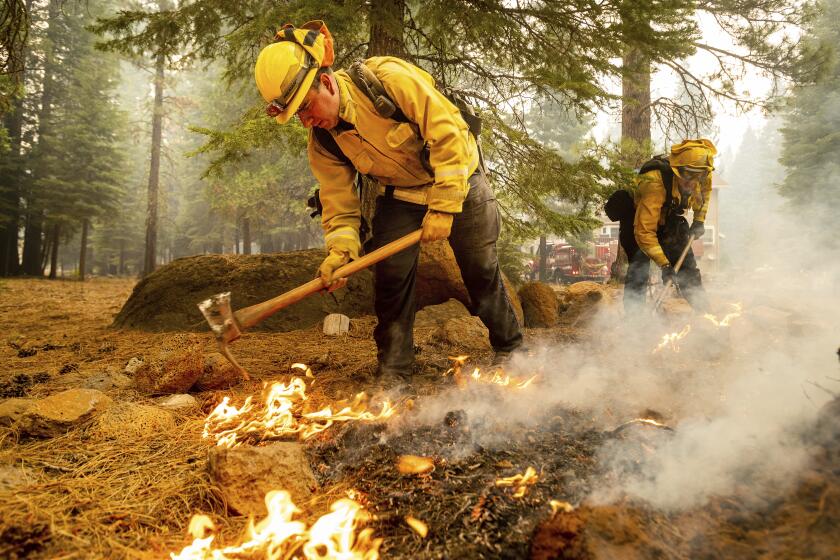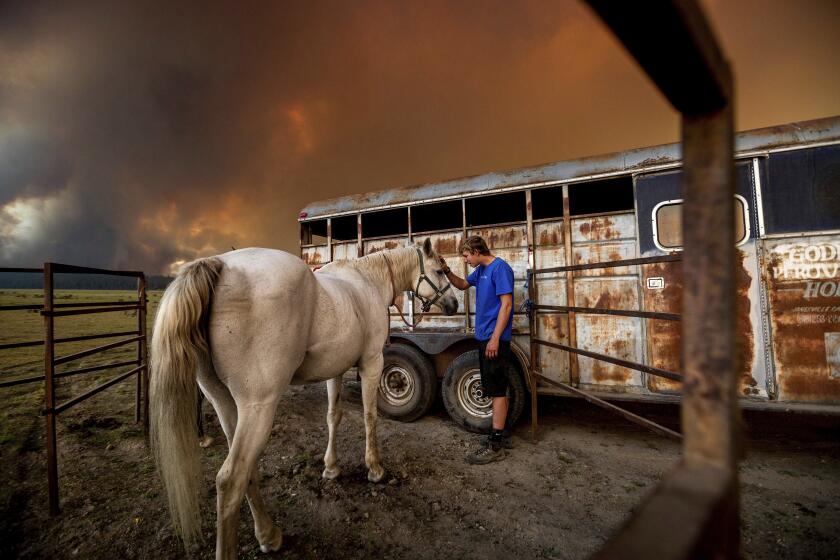Firefighters face unprecedented conditions as they try to save towns from Dixie fire

GREENVILLE, Calif. â The night operations section chief on the Dixie fire, Josh Campbell, has been in wildland firefighting for 25 years and at the branch level for seven of the largest fires in state history, said Capt. Mitch Matlow, public information officer on the fire.
âAnd he said, this is a direct quote, âIâve never seen fire behavior like this,ââ Matlow said.
Officials say a perfect storm of conditions has driven the Dixie fireâs rapid spread.
Early in the week, the Dixie fire continued to grow and the River fire burned homes north of Sacramento.
âItâs all of the things together,â Matlow said Thursday. âItâs the heat. Itâs the dry fuels. Itâs the drought. Itâs the wind we saw yesterday. Itâs the slope.â
The fire behavior analyst and incident meteorologist working on the fire predicted that it would slow down Friday because weather conditions were more stable and expected to remain so for the next seven or eight days, Matlow said, with the expiration of a red-flag warning Thursday night and slightly more humid conditions on tap.
There were 13,871 structures threatened and 31,732 people evacuated, he said.
The Dixie fire grew by 110,000 acres in a 24-hour period Thursday, double the 50,000 acres by which it expanded Wednesday, California Department of Forestry and Fire Protection spokesman Rick Carhart. said while also noting the favorable weather forecast.
The Dixie fire in Northern California exploded to 432,813 acres, growing more than 100,000 acres in 24 hours. Itâs the third-largest blaze in state history.
âThe forecast is for the fire activity to moderate as well,â he said. âSo it would be unexpected to see that much fire growth again today.â
The fire has grown so fast due to extreme conditions on the ground coupled with weather patterns, he said.
âIt is just so dry,â he said. âThe fuels have basically no moisture in them whatsoever. So there have been times during the fire when pretty much every time that an ember would spot and land in grass, it was almost guaranteed to ignite and start another spot fire.â
Those are conditions firefighters typically see later on in the summer as vegetation dries out, he said.
Although the town of Greenville was decimated and the community of Canyon Dam suffered heavy damage on Thursday, firefighters were able to hold the line around Chester, and there were no reports of homes burned in that area as of Friday morning, Carhart said.
The townâs logging mill was also saved, he said.âThe fire easily could have just gone in there and consumed that whole town,â he said. âAnytime they [firefighters] have success, it gives them the energy they need to go back in there and do it again the next day.â
Fire officials had positioned resources in populated areas, including all around Lake Almanor, whose western shore the fire has reached, he said. Firefighters were protecting homes there, and the fire had not advanced to the Lake Almanor Peninsula, he said.
Officials say a perfect storm of conditions â the heat, the dry fuels, the drought, the wind, the slope â has driven the Dixie fireâs rapid spread.
âBut with the two years of drought that weâve had, weâre just at those later summer conditions a couple months ahead of when we typically would be,â he said.
The fire started in steep, mountainous, âbasically cliffside terrainâ so remote it was hard to get firefighters on the ground to fight it, he said.
âWe do what we can but itâs been very labor intensive getting to these areas and getting tools on the ground to fight the fire,â he said. âThere were places where we couldnât even get a hose because we couldnât get an engine anywhere near where the fire was, so it was all hand tools and that kind of stuff.â
âThen, by the time the fire came out of those areas and started heading toward more populated areas like Lake Almanor, Greenville and Chester, the fire was so big that it was then building on its own,â he continued.
Once a fire grows to a certain size, under the right conditions, it can create its own self-sustaining weather patterns that help it grow even larger.
Once the fire moved out of the steep terrain, it got into areas with a lot of timber and no recent burn history, he said. The undergrowth served as so-called ladder fuel, allowing the fire to get up into the crowns of the trees.
Personnel attacking the Dixie fire are bracing for strong winds expected to arrive Wednesday afternoon that could make difficult conditions worse.
âThatâs where you also get very extreme fire growth, is from those trees spotting ahead of themselves,â Carhart said.
On top of that, the fire hit unburned islands of fuel inside the perimeter that threw embers across containment lines firefighters had established, he said.
In Greenville, crews were still assessing the damage, but itâs believed that three-quarters of the townâs buildings were consumed, fire spokeswoman Serena Baker said Thursday morning. At least 67 structures were destroyed, with more than 12,000 under threat, according to authorities.
Plumas County Sheriff Todd Johns, identifying himself as a lifelong resident of Greenville, struck a somber tone at a briefing Thursday night. âMy heart is crushed by what has occurred there, and to the folks that have lost residences and businesses â Iâve met some of them already â their life is now forever changed,â he said.
âAnd all I can tell you is, Iâm sorry.â
Greenville was a smoking ruin by Thursday morning, its street signs melted so that the lettering crackled like glaze. Entire blocks were razed. Flames still flickered where there was something left to burn. Hulls of cars lined the street, reduced to charred tanks and melted wheels.
The post office building was standing, but inside, the banks of mailboxes lay collapsed on the ground, their doors burned off.
The gas station was smoldering, its metal roof twisted and swollen, its pumps burned-out shells.
More to Read
Sign up for Essential California
The most important California stories and recommendations in your inbox every morning.
You may occasionally receive promotional content from the Los Angeles Times.
















